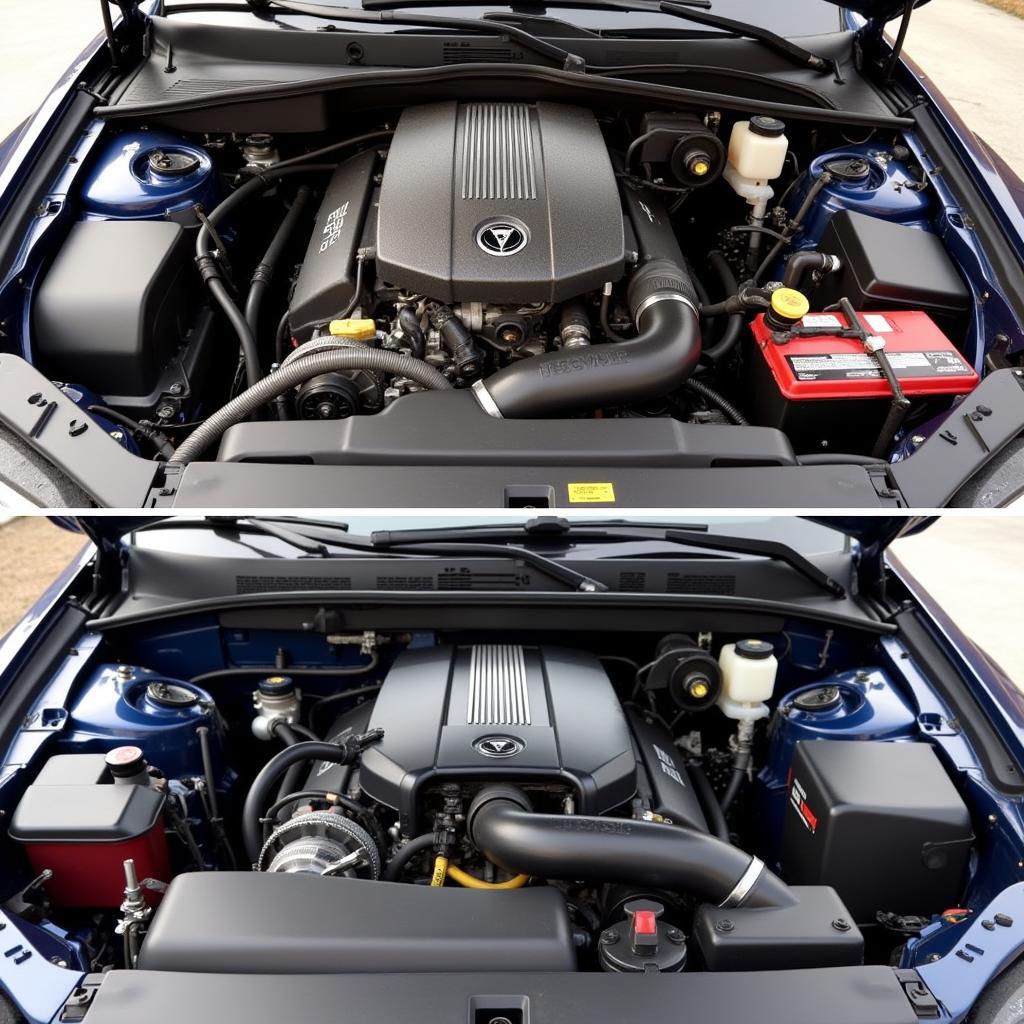Detailing a car engine not only enhances its appearance but also contributes to its longevity. A clean engine bay allows for easier identification of leaks and other potential problems, and also helps prevent the build-up of grime that can corrode components over time. This comprehensive guide will walk you through the process of how to detail your car engine safely and effectively.
Preparing Your Car Engine for Detailing
Before you begin, gather your supplies. You’ll need engine degreaser, various brushes (including a detailing brush and toothbrush), microfiber towels, a garden hose with a spray nozzle, plastic bags, masking tape, and a car wax or sealant. Safety is paramount, so also ensure you have gloves and eye protection.
Disconnect the negative battery terminal to prevent any accidental electrical shorts. This is a crucial first step. Next, cover sensitive components like the alternator, air intake, and any exposed electrical connections with plastic bags and secure them with masking tape. This protects them from water damage and the harsh chemicals in the degreaser.
Applying Engine Degreaser and Cleaning
Now, it’s time to apply the engine degreaser. Follow the instructions on the product label carefully. Generally, you’ll spray the degreaser evenly over the entire engine bay, avoiding the covered components. how to detail car engine compartment provides a more detailed explanation of this crucial step. Let the degreaser sit for the recommended time, usually a few minutes, allowing it to penetrate and loosen the grime.
Using your detailing brushes, agitate the grime and grease, paying attention to hard-to-reach areas. A toothbrush is perfect for tight spaces and intricate parts. how to detail car engine hose offers specific guidance on cleaning delicate engine hoses without causing damage. Rinse the engine bay thoroughly with the garden hose, using a gentle spray nozzle to avoid forcing water into sensitive areas.
Drying and Protecting the Engine
After rinsing, use microfiber towels to dry the engine bay completely. Excess water can cause corrosion, so ensure every nook and cranny is dry. Once dry, you can apply a car wax or sealant to protect the engine and enhance its shine. This also makes future cleaning easier.
Final Touches and Inspection
Reconnect the negative battery terminal. Start the engine and let it run for a few minutes to dry any remaining moisture. Inspect the engine bay for any missed spots or lingering grime. If necessary, repeat the cleaning process on specific areas. how much does it cost to detail a car engine offers insights into the costs associated with professional detailing services.
Maintaining a Clean Engine
Regularly wiping down your engine bay with a damp microfiber cloth can prevent the build-up of grime and maintain its pristine appearance. how to detail car engine bay offers helpful tips for routine engine bay maintenance.
What is the best degreaser to use?
Choose a degreaser specifically designed for automotive engines. Avoid harsh chemicals that could damage plastic or rubber components.
Can I use a pressure washer?
While a pressure washer can be effective, use it with extreme caution. The high pressure can force water into sensitive areas and cause damage.
How often should I detail my car engine?
Detailing your engine once or twice a year is generally sufficient, depending on driving conditions.
In conclusion, detailing a car engine is a rewarding task that improves both the aesthetics and longevity of your vehicle. Following these steps and precautions will ensure a safe and effective cleaning process. Remembering to detail your car engine is a key part of overall vehicle maintenance. how to detail an engine in a car provides further resources on this topic.
 A Spotless Car Engine After Detailing
A Spotless Car Engine After Detailing
FAQ:
- What is the first step in detailing a car engine? Disconnect the negative battery terminal.
- Why should I cover sensitive engine components? To protect them from water and cleaning products.
- What type of brush should I use? Detailing brushes and a toothbrush are recommended.
- How do I dry the engine bay? Use microfiber towels.
- How often should I detail my engine? Once or twice a year, depending on driving conditions.
- Can I use a pressure washer? Use with extreme caution as it can cause damage.
- What should I do after detailing? Reconnect the battery terminal and start the engine.
Need more help? Contact us via WhatsApp: +1(641)206-8880, or Email: [email protected]. Our customer support team is available 24/7.

Leave a Reply